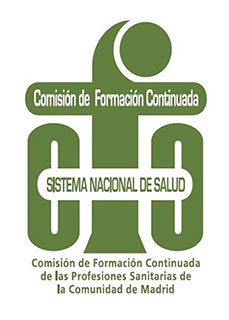Refresher Course on Hospital Pediatrics

Staying up-to-date on Hospital Pediatrics
At present, rapid and profound scientific and technological changes are taking place that make our knowledge outdated unless we stay up-to-date with the latest advances in our profession and specialty.
At the same time, the social demands and expectations in healthcare for the child population has high demands and pressure for professionals.
It is necessary for professionals to have updated knowledge and skills on different pathologies or action protocols in the hospital environment in order to respond to the daily challenges in the specialty of Pediatrics.
Curriculum
Refresher Course on Hospital Pediatrics
- 1. Refresher on Central Nervous System infections.
- Acute meningitis.
- Acute encephalitis.
- Brain abscess.
- Other suppurative intracranial infections.
- 2. Analgesia and sedation in Pediatric Emergencies.
- Analgesia in the pediatric emergency.
- Sedation in the pediatric emergency.
- 3. Inflammatory syndrome linked to SARS-COV2.
- Definition.
- Epidemiology.
- Pathophysiology.
- Clinic.
- Diagnosis.
- Differential diagnosis.
- Management and monitoring.
- Treatment.
- 4. Refresher on myocarditis and cardiomyopathy in pediatrics.
- Definition.
- Epidemiology.
- Pathophysiology.
- Clinic.
- Diagnosis.
- Differential diagnosis.
- Management and monitoring.
- Treatment.
- 5. Refresher on the most frequent arrhythmias in pediatrics.
- Bradyarrhythmias.
- Tachyarrhythmias.
- Channelopathies.
- Sudden death in pediatrics.
- 6. Refresher on respiratory infections. Hospital management.
- Community-acquired pneumonia.
- Nosocomial pneumonia.
- Bronchiolitis.
- Tuberculosis.
- 7. Management of seizures and the different epileptic syndromes in the Emergency Department.
- Management of seizures in the Emergency Department.
- o Febrile seizures and their treatment.
- Epileptic syndromes in childhood and adolescence. Treatment.
Professors
 Alberto Sánchez Calderón
Professor
Alberto Sánchez Calderón
Professor
More Academic Info
Aimed at:
Competences
At the end of the course, the student will have acquired the knowledge and skills to:
- 1. Perform the diagnosis and management of infections of the Central Nervous System.
- 2. Select the different complementary tests, taking into account their clinical value.
- 3. Adequately prioritize pediatric patients in the Emergency Department based on the degree of pain they present.
- 4. Apply analgesia and sedation measures in different urgent situations.
- 5. Adequately identify the patient with Pediatric Inflammatory Syndrome related to SARS CoV2. (SIM-PedS).
- 6. Carry out an adequate differential diagnosis in SIM-Peds with other similar entities.
- 7. Optimize the treatment of these patients.
- 8. Make an adequate diagnosis of cardiomyopathies.
- 9. Properly manage pediatric patients with myocarditis and/or cardiomyopathy.
- 10. Correctly identify the most frequent arrhythmias that occur in pediatrics.
- 11. Use the protocols for action and treatment for the different arrhythmias in the emergency room.
- 12. Identify the main respiratory infections of the lower respiratory tract in pediatrics within the pediatric emergency setting and the criteria for hospital admission.
- 13. Perform the Diagnosis and treatment of latent tuberculosis infection and pulmonary tuberculosis disease in Pediatrics.
- 14. Adequately treat the patient with a seizure in the pediatric emergency setting.
- 15. Adequately identify the different epileptic syndromes that occur in children and know the specific protocols for their initial management.
Objectives
- Carry out an updated review of different pathologies and action protocols in the context of Pediatric Emergencies, in order to provide quality care.
- Improve child care in the Emergency Department, with the optimization of analgesia and sedation procedures.
- Maintain and update professional competence by promoting autonomous and continuous learning.
Methodology
Taught in 15 teaching hours, distributed over 8 sessions: 7 sessions of 2 teaching hours and an evaluation session of 1 hour. The course is taught online through the virtual classroom of Nebrija Global Campus. The lectures scheduled in a calendar previously communicated to the students are broadcast live with the professor's initial teaching presentation and later an interaction with the students to answer questions and pose clinical cases.
- ive virtual lectures.
- Teaching material and bibliography provided by the teaching staff.
- Exercises for students with follow-up. Solving of a clinical case.
- Personalized tutoring sessions.
- The evaluation includes the student following the teaching content. The student will have to take a multiple-choice exam (50 questions, 5 possibilities with only one valid answer), and will need 60% of correct answers to obtain the certificate of achievement and to guarantee the assimilation of concepts and the fulfillment of the objectives. Post-course assessment survey on satisfaction of expectations.


